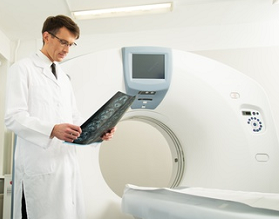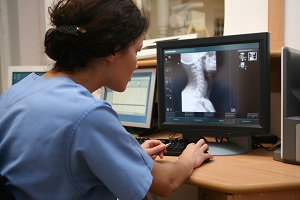The Acting Administrator of the Centers for Medicare and Medicaid Services (CMS), Andy Slavitt, recently posted this blog article that describes the successful transition to ICD-10 diagnosis code reporting on October 1, 2015. In it, Slavitt writes, “For thousands of physicians and other clinicians around the country, the change to ICD-10 was a big undertaking, requiring time, planning and a period of adjustment. But on October 1, proper execution and good implementation made all the difference.”
CMS Reflects on the Successful Implementation of ICD-10 on March 4, 2016
Categories: radiology reimbursement, radiology coding, icd-10
What Radiology Practices Need to Know About Reporting the New CT Modifier on January 7, 2016
One of the new coding requirements imposed by Medicare for 2016 is that practices attach a billing modifier to CT procedures performed with older CT equipment that does not meet the standards of NEMA XR-29-2013. Medicare’s payment for services billed with the new “CT” modifier will be reduced by 5% of the technical component. Both the Radiology Business Management Association (RBMA) and the American College of Radiology (ACR) have posted blog articles this week about the new requirements.
Categories: radiology reimbursement, radiology coding, CT imaging
How the 2016 Coding Changes will Affect Interventional Radiology Practices on December 29, 2015
In our two recent articles we covered the effect of changes to codes in the Current Procedural Terminology1 (CPT) for diagnostic radiology and radiation oncology. Now we turn our attention to CPT code changes for 2016 that affect interventional radiology (IR). As before, our analysis focuses on the effect those changes will have on practice revenue. Each practice’s experience will vary based on the volume of procedures that use the affected codes, and a volume-weighted analysis of the entire Medicare fee schedule is recommended to gain a complete understanding of the impact to the practice.
Categories: radiology coding, medicare reimbursement, interventional radiology
How the 2016 Coding Changes will Affect Radiology Practices on November 23, 2015
The annual cycle of revising codes in the Current Procedural Terminology1 (CPT)® has been completed with the issuance of the Medicare Physician Fee Schedule (MPFS) Final Rule for 2016, and radiology is one of the areas most affected by the changes. The traditional radiology section of codes, 70010 – 79999, has 60 additions, revisions or deletions and there are even more when the Interventional Radiology (IR) surgical codes are considered.
Categories: radiology reimbursement, radiology coding, interventional radiology, MPFS, MRI
Hidden Reductions in the Medicare 2015 Physician Fee Schedule on January 2, 2015
According to the American College of Radiology (ACR), “The technical component for more than 200 imaging procedures will be cut by up to 55 percent in the final 2015 Medicare Physician Fee Schedule (MPFS) because of a decision to remove the direct practice expense of numerous film inputs that affected their reimbursement rates in favor of the cost of acquiring a desktop computer.” The decreased reimbursement is sizable for such procedures as myelography, CTA and a variety of ultrasound studies. The ACR’s analysis was released in their recent eNews article Analog to Digital Conversion to Cost Radiologists. The article includes helpful impact tables showing the specific change in radiology reimbursement rates between 2014 and 2015 for each CPT code.
The changes cited by the ACR are the result of Medicare’s attempt to recognize that most practices today use digital PACS technology rather than film. They removed the costs associated with film production and storage, but replaced those costs with only the value of $2,501 to represent a typical radiology reading station. No recognition was given to the overall cost of installing and maintaining the central PACS hardware and software. The ACR reports that, as an example, CPT 76377 (3D Post-processing of tomographic modality) receives a 45.7% reduction for film-based costs offset by a gain of only 1.7% when the desktop computer is substituted.
Categories: radiology reimbursement, radiology coding, medicare reimbursement, MPFS
The Impact of Coding Changes on Radiology Practices in 2015 on December 23, 2014
Radiologists concerned with maximizing practice revenue in 2015 would do well to understand the nuances of new coding changes that can impact reimbursements. The majority of coding changes for 2015 involve either bundling two codes into one when those codes are most often reported in combination or the creation of new codes to clarify their usage. The resulting impact on an individual practice’s overall payment levels should be minimal but will depend on its actual procedure mix. One major item of note is that Medicare will begin to provide reimbursement for Digital Breast Tomosynthesis (DBT, sometimes referred to as 3D Mammography) beginning in 2015 in the form of a code to be added-on to digital screening and diagnostic mammography services, although reimbursement from commercial payers is not guaranteed.
Categories: radiology reimbursement, radiology coding
Is Your Radiology Practice Ready for the New HCPCS Modifiers? on October 9, 2014
Four new HCPCS modifiers will be available for use beginning in 2015, according to a recent announcement by the Centers for Medicare and Medicaid Services (CMS). Known collectively as the –X{EPSU} Modifiers, they will be used to define specific subsets of the CPT Modifier -59 for a “Distinct Procedural Service”. The new modifiers are intended to offer more precise coding options that will allow practices to avoid potential payment delays, audits and reviews associated with modifier -59. CMS says that -59 is the most widely used modifier, covering a wide variety of circumstances such as to identify different encounters, different anatomic sites and distinct services. Because modifier -59 is so broadly defined, it is often used incorrectly and inappropriately.
Categories: radiology billing, medicare, radiology coding, medicare reimbursement, modifier -59, mppr, X{EPSU} Modifiers, cms
How New MPPR Rules Affect Your Radiology Practice Revenue on September 24, 2014
As private insurance payers begin adopting the Multiple Procedure Payment Reduction (MPPR) methodology that was implemented by Medicare several years ago, practices that are not ready could face a revenue loss of 25% or more for some services. Of specific interest to radiologists is United Healthcare, which announced in its May 2014 Network Bulletin that it would be expanding its MPPR to the professional component of imaging services in alignment with Medicare’s policy. This change will apply to United Healthcare’s Commercial and Community Plan. Originally the policy was to take effect in the third quarter of 2014 but under pressure from radiology advocacy organizations, United has now reported that implementation of the policy will be delayed until the fourth quarter of 2014. This brief reprieve provides radiology practices with an opportunity to lessen this detrimental impact on their revenue by improving their current processing methodologies before these changes take place.
Categories: radiology reimbursement, physician reimbursement, radiology coding, revenue cycle management
Why Radiology Practices Should Not Stop Preparing for ICD-10 on August 12, 2014
The Centers for Medicare and Medicaid Services (CMS) said unequivocally that October 1, 2014 would be the date for mandatory implementation of the ICD-10 coding system and that there would be no further delays. CMS was overruled, however, with the signing of the Protecting Access to Medicare Act of 2014 (PAMA) on April 1, 2014, which directed that CMS could not adopt ICD-10 any earlier than October 1, 2015. Now that CMS has confirmed this revised start date in the Federal Register, radiology practices should not delay their preparations for the transition. Here are four steps your radiology practice can take to keep moving ahead with plans to be ready for ICD-10.
Categories: radiology documentation, radiology coding, icd-10
Recognizing Excellence in Medical Coding Professionals on August 1, 2014
HAP was recently named as the top medical coding company in this article by Medical Coding and Billing Online, a site dedicated to helping students explore education opportunities within the industry. In thanking them for this recognition, we also want to take the opportunity to recognize and thank our team of coding professionals for the excellence that they deliver to our clients on a daily basis.
Categories: radiology coding, icd-10, revenue cycle management













